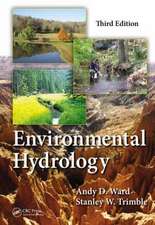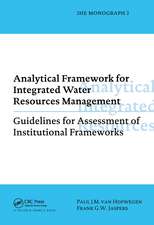Wetland Landscape Characterization: Practical Tools, Methods, and Approaches for Landscape Ecology, Second Edition
Autor Ricardo D. Lopez, John G. Lyon, Lynn K. Lyon, Debra K. Lopezen Limba Engleză Hardback – 27 mar 2013
A Practical Toolbox for Integrated Wetland Landscape Characterization
The book explains how to locate, identify, and map the extent of wetlands to learn more about their importance to society and the larger landscape. It examines jurisdictional, regulatory, and practical applications from the scientific, engineering, and lay perspectives. Fully updated, the second edition reflects an emerging infrastructural, ecosystem goods-and-services perspective to better assist readers who may encounter these concepts and challenges as they assess and characterize wetlands. Examples and case studies illustrate a variety of situations and solutions, highlighting the use of current techniques to assess, inventory, and monitor natural resources under changing conditions. These examples offer lessons and ideas for the issues encountered every day by wetland landscape ecology practitioners. The book also refers readers to additional resources to help them solve specific challenges.
New in This Edition
- Updates of practical geospatial methods
- More project-driven examples
- A description of the pitfalls of using ecological data at landscape scales, along with solutions
- Alternative techniques for a variety of practitioners
- Linkages between field and landscape ecological practices
- Online resources for practitioners
- New illustrations
Preț: 1100.66 lei
Preț vechi: 1556.38 lei
-29% Nou
Puncte Express: 1651
Preț estimativ în valută:
210.61€ • 220.48$ • 174.27£
210.61€ • 220.48$ • 174.27£
Carte tipărită la comandă
Livrare economică 05-19 aprilie
Preluare comenzi: 021 569.72.76
Specificații
ISBN-13: 9781466503762
ISBN-10: 1466503769
Pagini: 324
Ilustrații: 110 b/w images, 33 tables and N/A
Dimensiuni: 156 x 234 x 33 mm
Greutate: 0.59 kg
Ediția:Revizuită
Editura: CRC Press
Colecția CRC Press
ISBN-10: 1466503769
Pagini: 324
Ilustrații: 110 b/w images, 33 tables and N/A
Dimensiuni: 156 x 234 x 33 mm
Greutate: 0.59 kg
Ediția:Revizuită
Editura: CRC Press
Colecția CRC Press
Public țintă
Environmental and resource professionals in the fields of engineering, ecology, resource management, climate sciences, and policy development.Cuprins
Introduction: The Challenge. Key Themes Driving Landscape Characterization. Traditional to Contemporary Characterization Methods. Integrating Field-Based Data and Geospatial Data. Utilizing Broad-Scale Characterization Approaches. Determining Ecological Functions of Wetlands with Landscape Characterization. References. Appendix: Mississippi River and Surrounding Landscape. Index.
Notă biografică
Ricardo "Ric" Daniel Lopez, Ph.D. is a leader in the field of wetlands ecology and landscape ecology. He has led the way in novel applications of field-based and geospatial data analyses to solve current and future global environmental challenges. This body of work includes monitoring and assessing upland, aquatic, and wetland ecosystems, with particular focus on a wide variety of wetlands, rivers, and streams. Ric’s career has focused on the development and application of both broad-scale and community-based indicators of restoration, sustainability, and environmental risk. A native of Santa Barbara, California, Ric spent his youth knee-deep (or deeper) in the many wetlands and tide pools of the region.
John Grimson Lyon, Ph.D. was interested early on in wetlands as places of native vegetation. This interest was honed during youthful wanderings in the mountains and river valleys of the Pacific Northwest, California, Nevada, and Alaska. Systematic study at the undergraduate, graduate, and professional levels has yielded a body of work on remote sensing, mapping, identification, and characterization of processes in wetlands, and related ecosystems in the Great Lake states and Western United States.
Lynn Krise Lyon is a lifelong educator, writer, and artist. She spent a good portion of her youth playing in creeks and streams. As an adult, she has visited wetlands all over the United States with her husband, John. She abhors black flies and snakes, loves cranberry bogs, and fervently believes Michigan has the best wetlands in the world.
Debra Kim Lopez has dedicated her existence to the appreciation of literature and writing, global sustainability issues, and the social sciences. She values the importance of global initiatives for improving communities around the world; she has traveled extensively. Lopez has partnered with her husband, Ric, on a plethora of wetland and other environmental issues, ever since they first encountered one another on a common travel adventure 22 years ago.
John Grimson Lyon, Ph.D. was interested early on in wetlands as places of native vegetation. This interest was honed during youthful wanderings in the mountains and river valleys of the Pacific Northwest, California, Nevada, and Alaska. Systematic study at the undergraduate, graduate, and professional levels has yielded a body of work on remote sensing, mapping, identification, and characterization of processes in wetlands, and related ecosystems in the Great Lake states and Western United States.
Lynn Krise Lyon is a lifelong educator, writer, and artist. She spent a good portion of her youth playing in creeks and streams. As an adult, she has visited wetlands all over the United States with her husband, John. She abhors black flies and snakes, loves cranberry bogs, and fervently believes Michigan has the best wetlands in the world.
Debra Kim Lopez has dedicated her existence to the appreciation of literature and writing, global sustainability issues, and the social sciences. She values the importance of global initiatives for improving communities around the world; she has traveled extensively. Lopez has partnered with her husband, Ric, on a plethora of wetland and other environmental issues, ever since they first encountered one another on a common travel adventure 22 years ago.
Recenzii
"The main strengths of the book include its practical geospatial approaches and rich case study examples… . This is an excellent reference book, one of a kind, for a variety of wetland landscape characterization issues."
—Professor Wei "Wayne" Ji, University of Missouri–Kansas City, USA
"Wetland Landscape Characterization will clearly be an invaluable resource for scientists and professionals involved in wetlands assessment and monitoring. The authors provide an in-depth understanding of traditional-to-contemporary methods of characterizing wetlands, the methods used to integrate field-based and geospatial data, the keys to analysis at multiple scales, and determining the ecological function of wetlands. These topics are brought to life through a wide range of case studies that provide the reader with an invaluable learning tool and significant new insight. Wetland Landscape Characterization is an essential reference for all those involved in wetland ecology."
—Stuart E. Marsh, University of Arizona, Tucson, USA
"… provides good technical explanations of concepts such as an ‘ecological indicator’ or ‘landscape metrics’, which allows the non-specialist reader to understand the methodology used in assessment of wetland health and habitat risk. I also appreciated the discussion linking ecosystem services to the health of the White River aquatic ecosystems, which drives home the importance of proper wetland management. The concept of the Unified Vulnerability Index (UVI) is presented clearly, providing a novel, yet comprehensive indicator to ascertain in a holistic manner. It is a strength of the material that the pros and cons of the UVI are mentioned in some detail."
—Douglas Cripe, Scientific Officer, Group on Earth Observations (GEO) Secretariat, Geneva, Switzerland
"The book explains how to locate, identify, and map the extent of wetlands to learn more about their importance to society and the larger landscape. It examines jurisdictional, regulatory, and practical applications from the scientific, engineering, and lay perspectives. Fully updated, the second edition reflects an emerging infrastructural, ecosystem goods-and-services perspective to better assist readers who may encounter these concepts and challenges as they assess and characterizewetlands."
––Northeastern Naturalist, Volume 20, 2013
—Professor Wei "Wayne" Ji, University of Missouri–Kansas City, USA
"Wetland Landscape Characterization will clearly be an invaluable resource for scientists and professionals involved in wetlands assessment and monitoring. The authors provide an in-depth understanding of traditional-to-contemporary methods of characterizing wetlands, the methods used to integrate field-based and geospatial data, the keys to analysis at multiple scales, and determining the ecological function of wetlands. These topics are brought to life through a wide range of case studies that provide the reader with an invaluable learning tool and significant new insight. Wetland Landscape Characterization is an essential reference for all those involved in wetland ecology."
—Stuart E. Marsh, University of Arizona, Tucson, USA
"… provides good technical explanations of concepts such as an ‘ecological indicator’ or ‘landscape metrics’, which allows the non-specialist reader to understand the methodology used in assessment of wetland health and habitat risk. I also appreciated the discussion linking ecosystem services to the health of the White River aquatic ecosystems, which drives home the importance of proper wetland management. The concept of the Unified Vulnerability Index (UVI) is presented clearly, providing a novel, yet comprehensive indicator to ascertain in a holistic manner. It is a strength of the material that the pros and cons of the UVI are mentioned in some detail."
—Douglas Cripe, Scientific Officer, Group on Earth Observations (GEO) Secretariat, Geneva, Switzerland
"The book explains how to locate, identify, and map the extent of wetlands to learn more about their importance to society and the larger landscape. It examines jurisdictional, regulatory, and practical applications from the scientific, engineering, and lay perspectives. Fully updated, the second edition reflects an emerging infrastructural, ecosystem goods-and-services perspective to better assist readers who may encounter these concepts and challenges as they assess and characterizewetlands."
––Northeastern Naturalist, Volume 20, 2013
Descriere
This book provides practical tools and methods to help practitioners more effectively locate, identify, and map the extent of wetlands, and therefore better understand the importance of wetlands to society and the larger landscape. The authors address jurisdictional, regulatory, and practical applications from the scientific, engineering, and lay perspectives. Numerous techniques, examples, figures, and lessons learned supply the ideas and solutions necessary for solving the complex issues associated with wetlands. This second edition has been updated throughout and includes more techniques, examples, and illustrations.



















